...
The next tab is the list of AWS Kinesis Stream endpoints that the module should connect to to push Tag data. Image Added
Image Added
 Image Removed
Image Removed
One or more AWS Kinesis Stream endpoints can be configured on this tab. The configuration options for an AWS Kinesis Stream connection are listed below.
...
- Setting Name
- This is a friendly name of the AWS Kinesis Stream used to easily identify it. This must also be unique.
- Enabled
- Whether to enable/disable this setting
- Use AWS Keys
- Whether to use AWS access and secret keys or use an AWS EC2 instance with an AWS IAM role
- AWS Access Key
- The AWS Access Key ID.
- Example: AKIAIOSFODNN7EXAMPLE
- Password/AWS Secret Key
- The AWS Secret Access Key.
- Example: wJalrXUtnFEMI/K7MDENG/bPxRfiCYEXAMPLEKEY
- AWS Session Tokens
- Whether to use AWS session tokens
- Role ARN
- Session Duration
- Session Name
- Region
- Set
- The Set to associate this AWS Kinesis Stream connection with.
- Stream Name
- The name of the AWS Kinesis Stream.
- Firehose Stream
...
- Store & Forward Enabled
- Whether to enable Store & Forward capabilities for this stream
- Store & Forward Type
- The type of the Store & Forward mechanism options: In_Memory and Disk_Backed (available in release 4.0.17 and higher)
- Data stored with an In_Memory Store & Forward will not be persisted across a module configuration change, module disable/enable, module restart or power loss
- Data stored with a Disk_Backed Store & Forward will persist across a module configuration change, module disable/enable, module restart or power loss
- Message Capacity - deprecated in 4.0.19
- The maximum number of messages to store before dropping the oldest historical messages
- History Max Size
- The maximum number of megabytes history can use before dropping the data
- In_Memory Store & Forward will use the Ignition Java Heap memory
- Max History Age
- The maximum number of minutes to store history before dropping the data
- Flush Period
- The period of time to wait (in milliseconds) between sending when flushing messages
...
- Partition Key Count
- The number of partition keys to use for inserts
- Partition Key
- An optional partition key pattern that supports token substitution for the following message fields: ${group}, ${edgenode}, ${device}. This should only be configured if explicitly defined partition keys are necessary when inserting into the Kinesis Stream.
- Max Message Size
- The maximum message size in bytes to send. Generally, this should match the max message size allowed by AWS Kinesis.
Advanced Store & Forward
- H2 Database Port
- TCP Port to connect to H2 Database for Disk_Backed Store & Forward
Clicking on the "Create new Kinesis Stream Setting..." link will bring up the following form for adding a new AWS Kinesis Stream endpoint.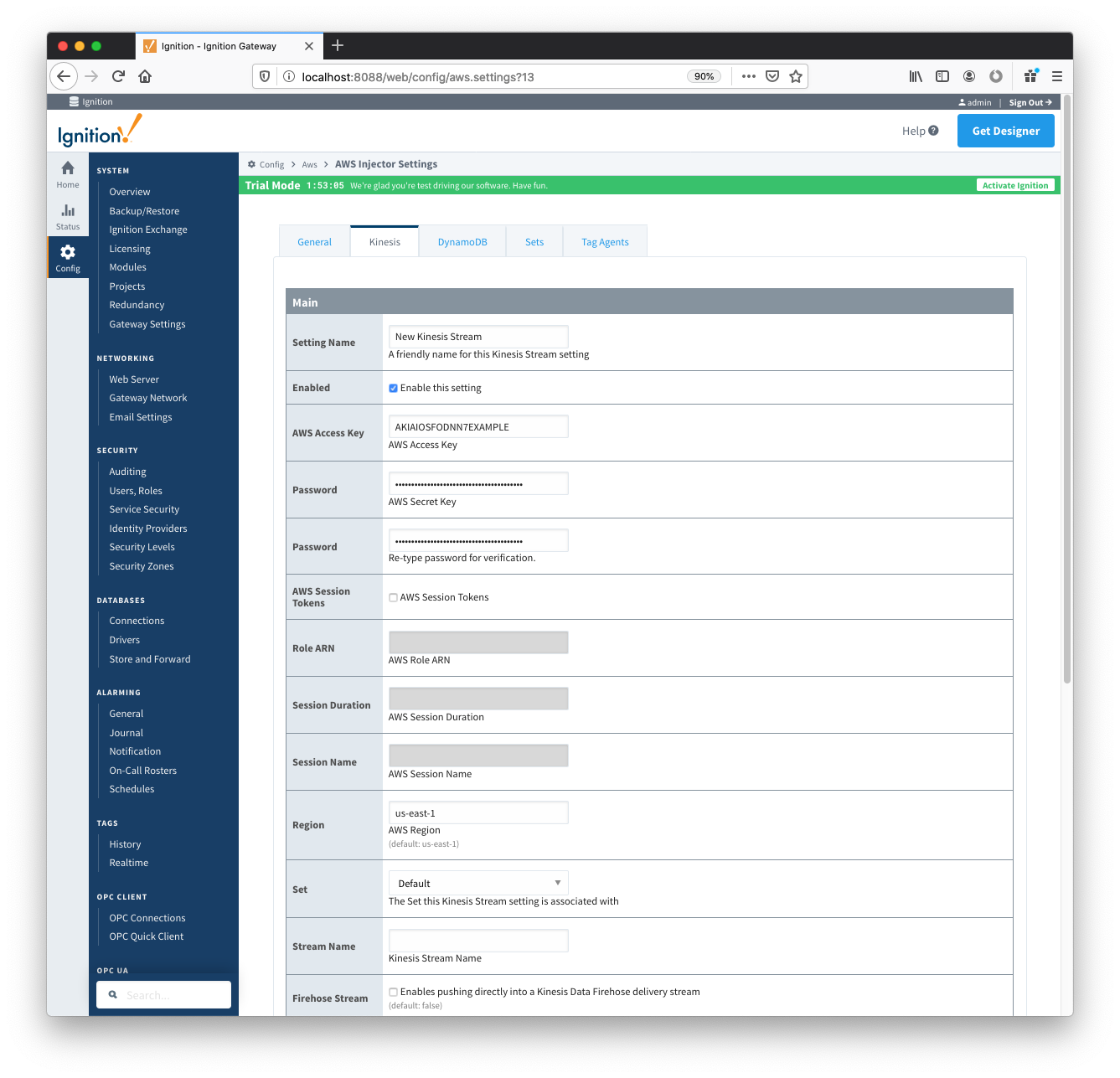 Image Removed
Image Removed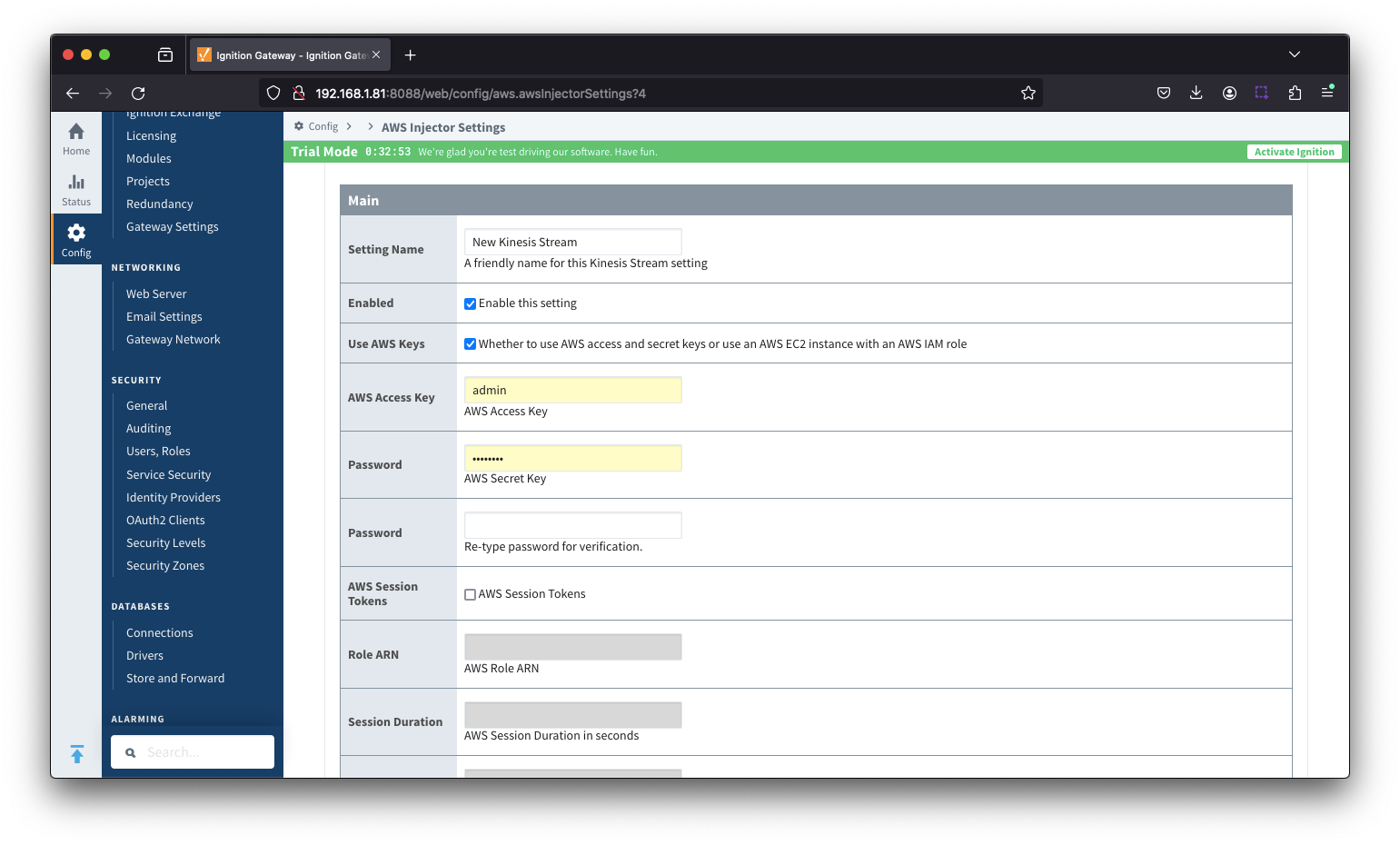 Image Added
Image Added
DynamoDB Databases
The third tab is the list of AWS DynamoDB Database endpoints that the module should connect to to push Tag data.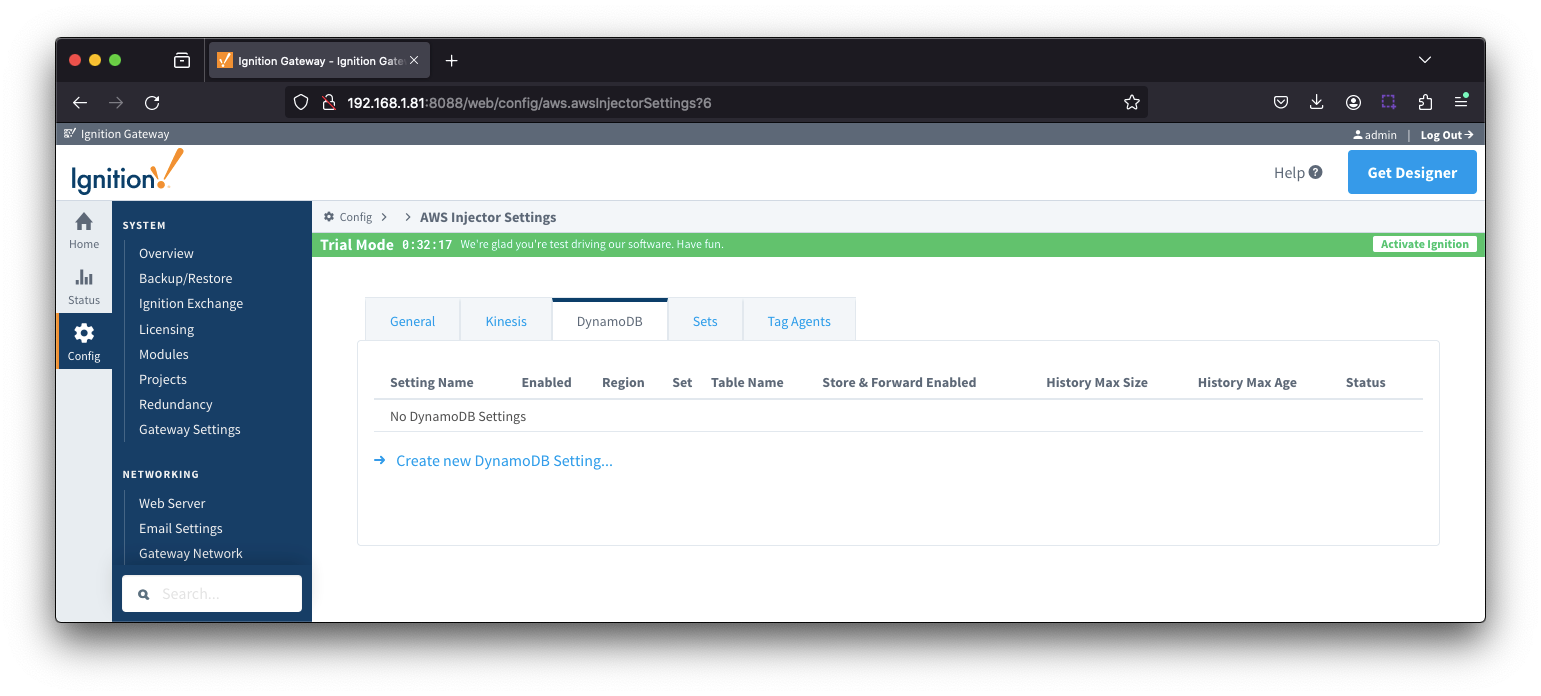 Image Added
Image Added
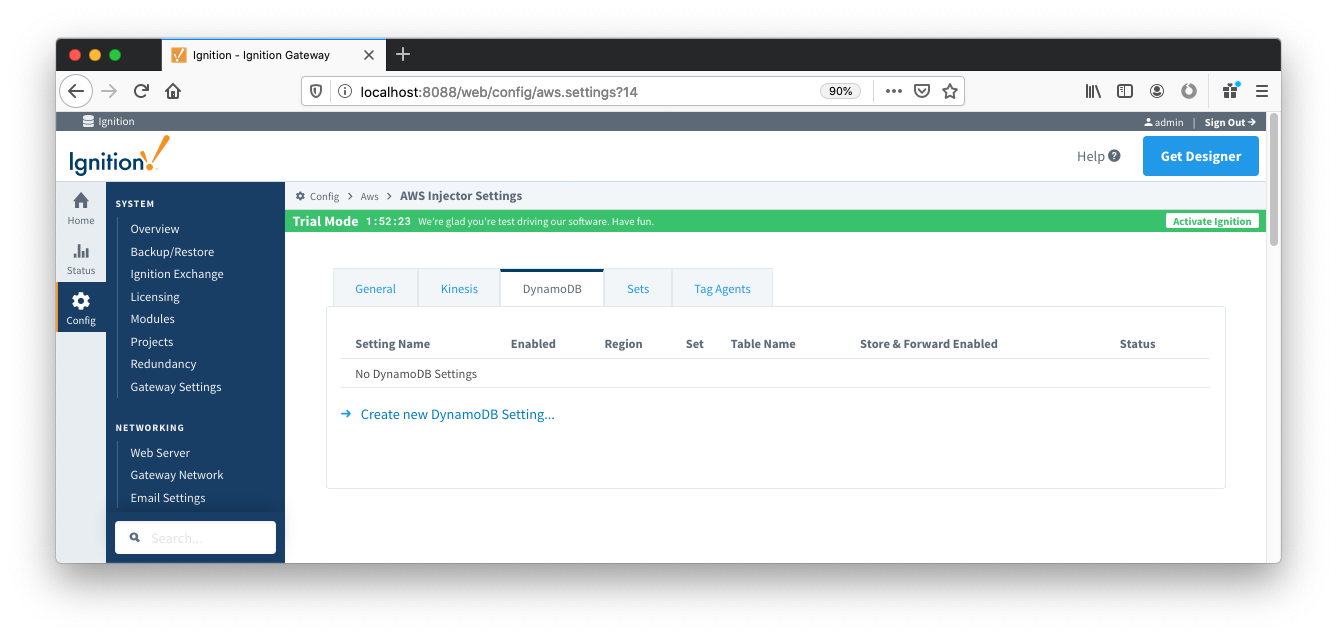 Image Removed
Image Removed
One or more AWS DynamoDB Database endpoints can be configured on this tab. The configuration options for an AWS DynamoDB Database connection are listed below.
...
- Setting Name
- This is a friendly name of the AWS Kinesis Stream used to easily identify it. This must also be unique.
- Enabled
- Whether to enable/disable this setting
- AWS Access Key
- The AWS Access Key ID.
- Example: AKIAIOSFODNN7EXAMPLE
- Password/AWS Secret Key
- The AWS Secret Access Key.
- Example: wJalrXUtnFEMI/K7MDENG/bPxRfiCYEXAMPLEKEY
- RegionTable Name
- Set
- The name of the Set to associate this AWS DynamoDB Database tableconnection with.
Set - Table Name
- The Set to associate this name of the AWS DynamoDB Database connection withtable.
Store & Forward
- Store & Forward Enabled
- Whether to enable Store & Forward capabilities for this stream
- Store & Forward Type
- The type of the Store & Forward mechanism options: In_Memory and Disk_Backed (available in release 4.0.17 and higher)
- Data stored with an In_Memory Store & Forward will not be persisted across a module configuration change, module disable/enable, module restart or power loss.
- Data stored with a Disk_Backed Store & Forward will persist across a module configuration change, module disable/enable, module restart or power loss.
- Message Capacity - deprecated in 4.0.19
- The maximum number of messages to store before dropping the oldest historical messages
- History Max Size
- The maximum number of megabytes history can use before dropping the data
- In_Memory Store & Forward will use the Ignition Java Heap memory
- History Max Age
- The maximum number of minutes to store history before dropping the data
- Flush Period
- The period of time to wait (in milliseconds) between sending when flushing messages
Advanced Store & Forward
- H2 Database Port
- TCP Port to connect to H2 Database for Disk_Backed Store & Forward
Clicking on the "Create new DynamoDB Setting..." link will bring up the following form for adding a new AWS DynamoDB Database endpoint. Image Removed
Image Removed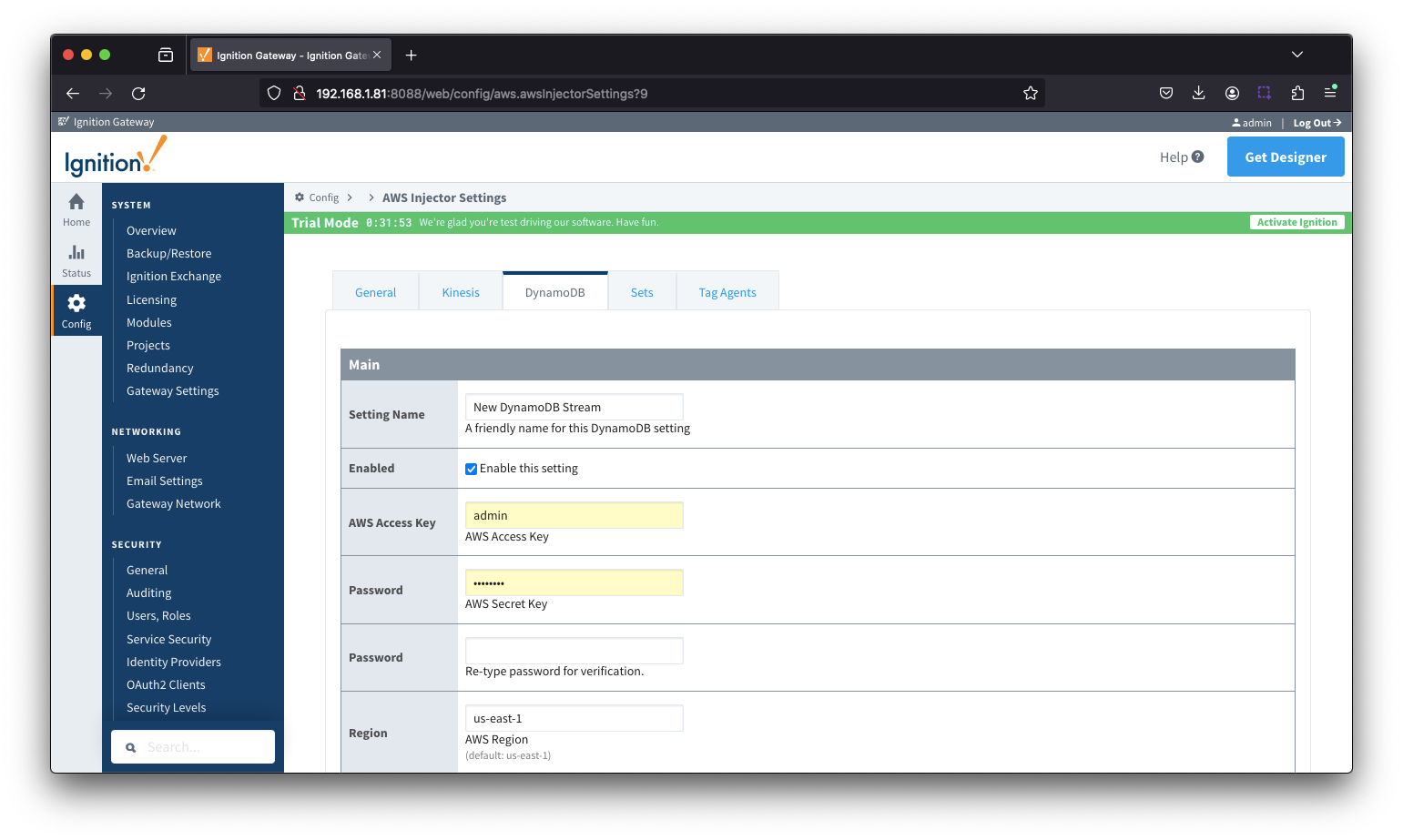 Image Added
Image Added
Sets
...
Tag Agents are the workers within AWS Injector that monitor tag events, convert them to a JSON representation, and push them to one or more AWS endpoints. Out of the box the AWS Injector module will have one "default" Tag Agent defined.
...
- Name
- A unique name for the tag agent.
- Enabled
- Sets whether the Tag Agent is enabled or disabled. If disabled, the Tag Agent will not run and no data will be pushed to any configured endpoints.
- Tag Provider Name
- The name of the Tag provider containing the tags.
- Tag Path
- An optional folder path under the Tag provider where the root folder of the Tags can be found.
- Push Trigger
- Defines what triggers a push to the cloud endpoint
- EVENT_DRIVEN (default) - when a tag change event occurs, and no pending push exists, tag events will be aggregated for the 'Tag Pacing Period' before being pushed
- PERIODIC - will push data for all tags associated with the Agent every 'Tag Pacing Period'
- Tag Pacing Period
- The buffer period, in milliseconds, that Tag events will be aggregated into a single payload before pushing.
- Convert UDTs
- Whether to convert UDT members to normal Tags before publishing. If enabled the Tags representing the UDT member will retain their member path prefixed by the UDT Instance name.
- Publish UDT Definitions
- This can only be set if 'Convert UDTs' is false
- Whether or not to push the UDT Definitions in the the NBIRTH messages
- Optimize UDTs
- This can only be set if 'Convert UDTs' is false
- Whether or not to 'convert UDTs' only for DATA messages.
- Set
- The Set of AWS endpoints that the Tag Agent will push to.
...
As you can see, the Sparkplug settings can be used to either hard-code these IDs, or leave them blank so that the Agent will scan and discover them based on the tag tree layout. For more information see this document keeping in mind that MQTT Transmission Transmitters can be thought of like 'Agents' in Injectors with regard to Sparkplug IDs and tag treesthe Cloud Injector Tag Agents and Tag Trees document.
Advanced
- Filtered Properties
- A semicolon delimited list of Tag properties to filter/block from being published. These should typically not be modified unless there is an explicit requirement that a specific property is needed to be added or removed from the default.
...
![]()
![]()
![]()
![]()
![]()
![]()
![]()
![]()
![]()